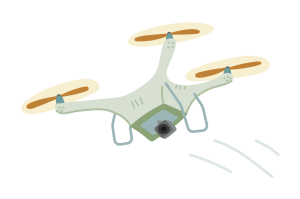Why is autonomy and automation interesting?
Because automation and autonomy help making processes and tasks easier to perform, more safe, and better at performing the task. By utilizing technology to solve repeated and tedious tasks, human skills and creativity can be spent on key tasks.
Automation and autonomy
Using technology to automate tasks and work processes have been a main enabler of the industrialization where fewer people have produced more. Ever since the digitalization started following the development of computers, systems for automating tasks have become increasingly popular. The key idea in an automation system is that part of the manual work have been replaced by technology that can do it automatically.

Some examples of automated systems are
- GPS steering and headland automation.
- Automated removal of manure and beeding in boxes.
- Control of grain dryers.
- Section control of crop protection sprayers.
A similar simplified explanation of autonomy can be made by considering a system that has reached a level of automation where it can solve its task completely independently without human interaction. Even though the autonomous system can solve its dedicated task without human support, a human operator is still needed to start, maintain, move, and plans for the autonomous system. Hande hence humans are still needed to solve the task.
An autonomous system often require a dedicated software and hardware in combination with a skilled farmer that understands technology. We will dig into these considerations in future themes related to autonomy and its use to increase efficiency on farm and in business operations.
Two examples of autonomous systems
In future Agtech Letters and Agtech Deep Dives, we will dig into several examples of autonomous systems to better understand how they function, what they do, and why you should or shouldn’t consider to use them in you operations. The strategic implications from autonomous solutions will be further investigated in our Agtech Strategic Insight reports.
Milking robots
One area in farming where the development of automated solution has gone far enough to start talking about autonomy is milking robots where cows can be scanned, prepared, and milked without direct human interaction. A milking robot enables more cows per employee at the same time as more precise data for each cow can be collected efficiently.
Self-driving tractors
Self-driving tractors are developed by many manufacturers today, and lots of time, effort, and money is spent on this. Some models are developed from scratch to become an autonomous tractor, while others are creating retrofit kits for their existing product lines of tractors. Self-driving tractors of both types are used commercially today in several regions.
Strategic Outlook
There is an ongoing “Race to autonomy” in the society today, probably most pronounced in the strive for autonomous cars. The agricultural business is no exception but rather the development speed is fast and the use-cases are plenty in our business. This will affect large parts of the business and its operations and having a good strategy for investing and implementing technology will be important to maintain competitiveness.
The fast development of autonomy in agriculture is driven both by stakeholders in the farming business and by outside stakeholders that want to get access to the huge future market of autonomous farming equipment. To stay in the driver’s seat during this transformation a good understanding of the technology will be paramount.
Key components of agtech solutions
Different agtech solutions used in the farming business are often based on the same key components, and getting a good understanding of these and what they are will make it easier for you to learn and understand new technology. Here, we list some of the most important components and we will dig deeper into these in future Agtech Letters and Agtech Deep Dives.
Data storage and Data
Data is a central part in most agtech solutions and it can be of several different types, qualities, and value.
Cost effective data storage and handling is important in agtech solutions to keep the costs for the technology down.
Example: Storing weather data such as temperature in the “cloud”.
Hardware and Software
Hardware for measuring, changing, and computing things are important building blocks in agtech solutions.
Software is a collection name for the programs at different levels that are run in computers to tell them what to do.
Example: A digital rain sensor that measures precipitation regularly.
Models and Algorithms
A model is sort of a description that computers use to understand a system. They range from simple to very complex.
Algorithms can be seen as prescriptions, or clear descriptions, of how to solve a certain task by the computer.
Example: Estimate the amount and timing of rainfall during the coming days.
Agtechers' Actions
Create a list with the most boring, heavy, and or repeated tasks in your operations. Can they be solved automatically? Are there any automated solutions available today?
In the next Agtech Letter we will concretize the information from this and the previous letter by showing an example where local weather data is collected using a weather station.


